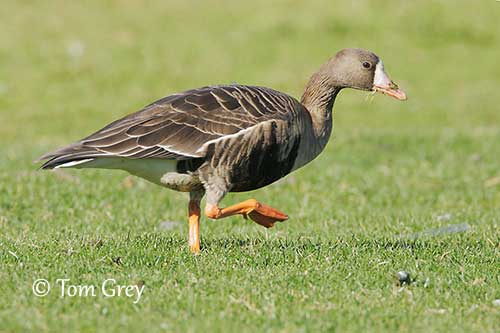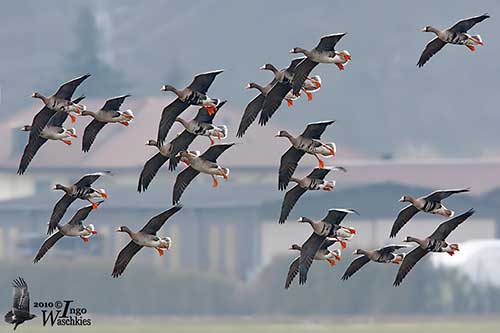
Fr: Oie rieuse
Ang: Greater White-fronted Goose
All: Bläßgans
Esp: Ánsar careto
Ita: Oca lombardella
Nd: Kolgans
Sd: Bläsgås
Photographers:
John Anderson
John Anderson Photo Galleries
Tom Grey
Tom Grey's Bird Pictures & Tom Grey's Bird Pictures 2
Otto Plantema
Trips around the world
Ingo Waschkies
My bird pictures on Pbase
Text by Nicole Bouglouan
Sources:
HANDBOOK OF THE BIRDS OF THE WORLD vol 1 by Josep del Hoyo-Andrew Elliot-Jordi Sargatal - Lynx Edicions - ISBN: 8487334105
THE COMPLETE BOOK OF BRITISH BIRDS – Written by “Royal Society for the Protection of Birds” experts - Préface de Magnus Magnusson - Michael Cady- Rob Hume Editors - ISBN: 0749509112
THE HANDBOOK OF BIRD IDENTIFICATION FOR EUROPE AND THE WESTERN PALEARCTIC by Mark Beaman, Steve Madge - C. Helm - ISBN: 0713639601
GUIDE DES CANARDS, DES OIES ET DES CYGNES – de Steve Madge - Delachaux et Niestlé - ISBN: 2603013769
ENCYCLOPEDIE DES OISEAUX DE FRANCE ET D’EUROPE – de Peter Hayman et Rob Hume - Flammarion – ISBN : 2082009920
FIELD GUIDE TO THE BIRDS OF NORTH AMERICA - National Geographic Society - ISBN: 0792274512
Animal Diversity Web (University of Michigan Museum of Zoology)
All About Birds (Cornell Lab of Ornithology)
Bird Web (Seattle Audubon Society)
What Bird-The ultimate Bird Guide (Mitchell Waite)
Wikipedia, the free encyclopaedia
Greater White-fronted Goose
Anser albifrons
Anseriformes Order – Anatidae Family
INTRODUCTION:
The Greater White-fronted Goose is part of the subfamily Anserinae and tribe Anserini that include the swans and the “true” geese. The geese of genus Anser are usually mostly grey, with insignificant differences between male and female.
The species is divided into 5 or 6 subspecies, depending on the authors. The race A.a. frontalis from Siberia is larger, with longer bill, and from a 2012’s study, it does not merit a subspecies status.
These subspecies share a wide range both in Old World and New World. They breed in the northernmost parts and migrate southwards to winter in more temperate regions. They favour wet habitats in all seasons, breeding in open tundra near marshes and wintering in open country on farmland and marshy habitats.
The Greater White-fronted Goose is threatened by intense hunting pressure, disturbances and degradation of the habitat, but it is currently not globally threatened.

DESCRIPTION OF THE BIRD:
Biometrics:
Length: 65-86 cm
Wingspan: 130-165 cm
Weight: M: 2000/3600 g – F: 1800/2900 g
The Greater White-fronted Goose is often confused with the Lesser White-fronted Goose, but the latter is darker and smaller, with larger white area on the forehead and yellow eyering, smaller and brighter pink bill and darker head, neck and upperparts.
The Greater White-fronted Goose has brownish-grey head, neck and back, whereas the rump is white. The tail is black with white terminal band.
The underparts are barred and flecked with black on lower breast. Belly and undertail-coverts are white. Foreneck, upperbreast and flanks are like the upperparts.
On the head, there is an extensive white patch around the base of the bill, outlined by indistinct blackish band.
The bill is pink but yellower towards the base, and with yellowish-white nail. The eyes are dark brown. Strong legs and webbed feet are yellow-orange to orange.
Some males may have an indistinct yellow eyering.
Male and female have similar plumage, but the male is larger.
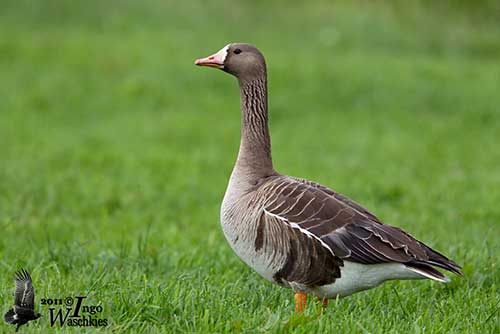
The juvenile lacks the white area around the bill, and the black markings on the underparts. The bill is duller with dark nail. The eyes are much paler than in adults. The young bird can breed at 3 years old.
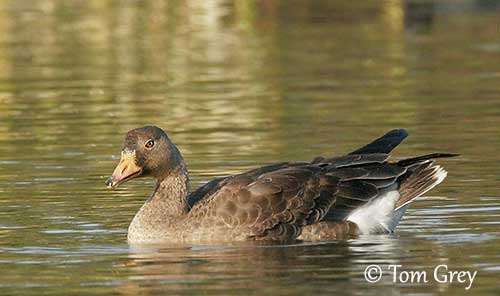
SUBSPECIES AND RANGE:
The Greater White-fronted Goose has 5 or 6 subspecies depending on the authors.
A.a. albifrons breeds in N Russia and Siberia, from Kanin Peninsula to R Kolyma. It winters in NW, C and SE Europe to SW Asia, Pakistan, N India and China.
A.a. gambelli breeds in taiga of N and C Alaska and NW Canada. It winters in SW USA and Mexico.
This race is larger than other North American races.
A.a. sponsa breeds in SW Alaska. It winters in California and W Mexico. Race not described.
A.a. elgasi breeds in S Alaska (Cook Inlet) and winters in California (Sacramento Valley).
This race is larger and darker than “gambelli” and often shows a yellow eyering.
A.a. flavirostris breeds in W Greenland and winters on British Islands.
This race is larger and darker than nominate on head and upperparts. It has yellow-orange bill, mostly pale pink towards the tip.
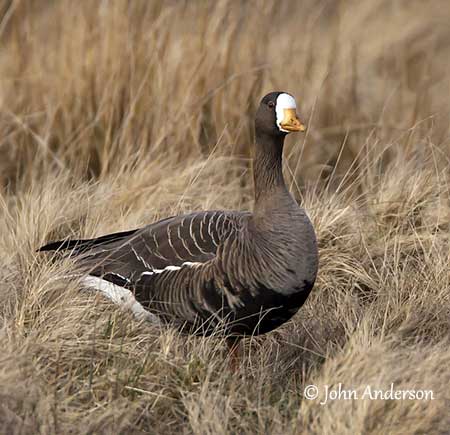
A.a. frontalis is added by some authors.
This race breeds in NE Siberia, from R Kolyma, E to Arctic Canada. It winters along the coast of Pacific Ocean, S to China and Mexico.
This race has slightly longer bill. It is larger and darker above.
HABITAT:
The Greater White-fronted Goose breeds in open tundra, usually close to lakes, streams, rivers and marshes. It may also breed inland or near the coasts.
The winter habitat includes cultivated areas with shallow standing water, but it also frequents freshwater marshes. The same type of habitat is also used during migrations.
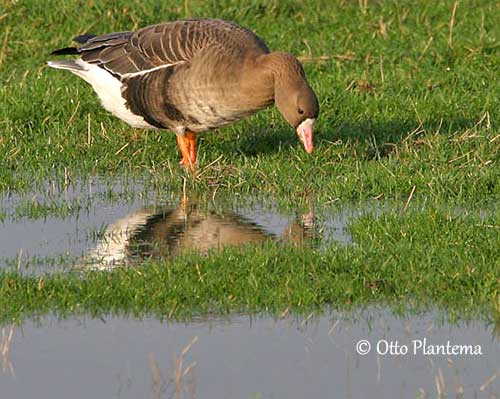
CALLS AND SONGS: SOUNDS BY XENO-CANTO
The Greater White-fronted Goose is a noisy bird. Within flocks, they communicate by series of honks, also used in alarm, and typical cackling. In flight, they give repeated, musical “liok liok” of varying pitch. During the defence of territory, they produce hisses and use adapted postures towards intruders.
The call is a high-pitched, laughing “kah-lah-aluck”.
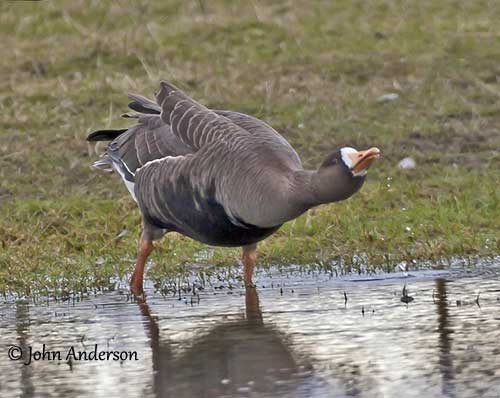
BEHAVIOUR IN THE WILD:
The Greater White-fronted Goose feeds primarily on plant material such as grasses, grains and berries. However, during the breeding season, adults and young feed mostly on invertebrates including molluscs, crustaceans, aquatic insects and marine worms.
During winter, it feeds mainly on grains, rice and soybeans, and in late winter, it takes buds of various plants.
It feeds by grazing on dry land, but in moonlit, it also forages on flooded fields. It dabbles when feeding in the water.
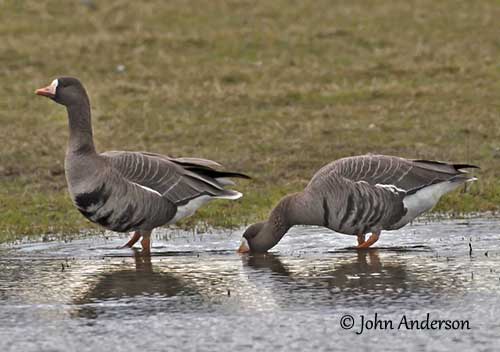
The Greater White-fronted Goose forms huge flocks outside the breeding season, including 10,000-15,000 birds, and sometimes up to 30,000 individuals. They are often busy, noisy and quarrelsome, and quickly alarmed. However, after the breeding season, they remain in small groups of 20-25 individuals until moulting.
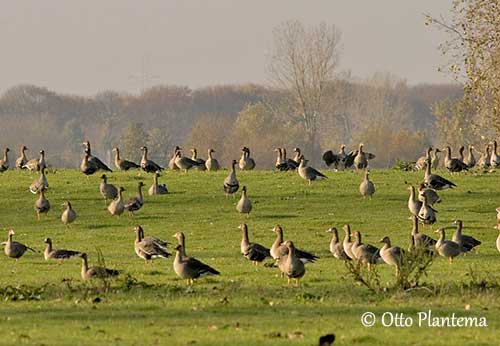
The Greater White-fronted Goose is monogamous with long-term pair-bonds. The pairs form in autumn or in early spring, after some ritual displays accompanied by loud calls from both mates. They are territorial during the breeding season.
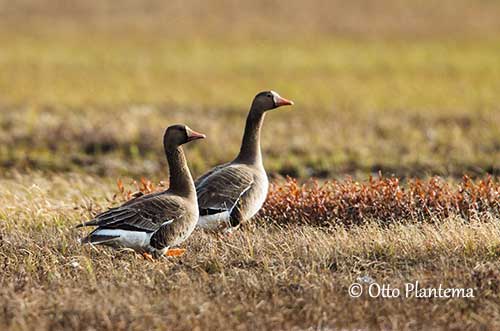
The Greater White-fronted Goose is migratory. The birds move S after moulting. They reach the temperate regions of Europe, Asia and North America. They leave the breeding grounds in early September and the return migration starts in March. They arrive in late April at their nesting sites.
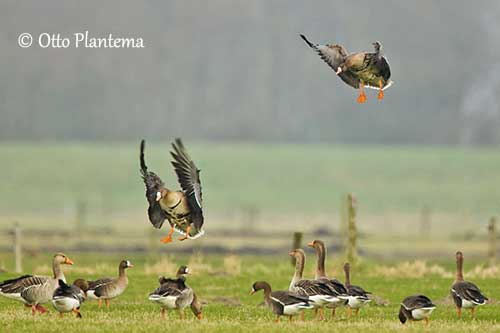
The Greater White-fronted Goose is usually more agile than the Greylag Goose, especially landing and taking-off. While flying, the flocks cross the sky in V-shaped lines and chevrons.
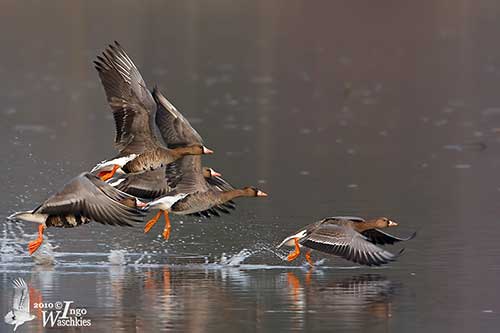
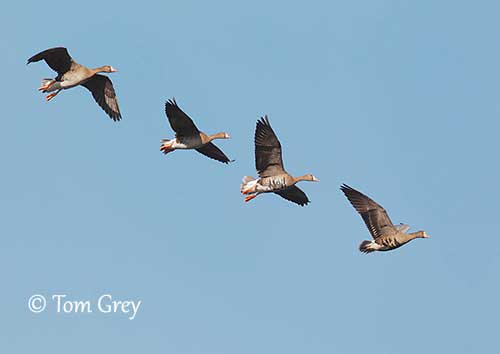
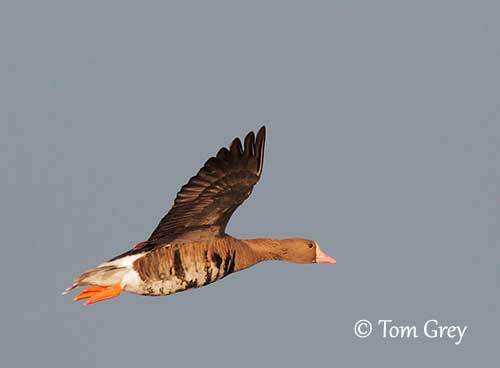
REPRODUCTION OF THIS SPECIES:
The breeding season starts in late May/early June. The Greater White-fronted Goose may nest in loose groups or in single pairs.
The nest is on the ground, a shallow depression among the vegetation, grass, low shrubs, short heath and sedges. The nest is sparsely lined with down and feathers. It is placed near water, on ice-free slopes or in upland areas. The nest is defended by both adults.
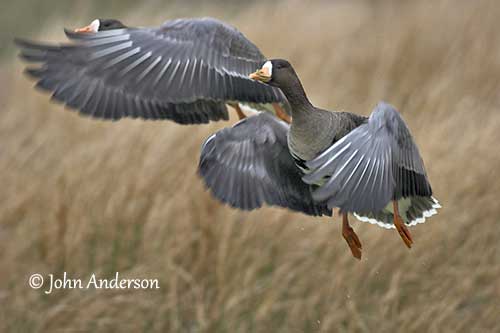
The female lays 5-6 whitish eggs and incubates alone during 22-27 days. The male guards her but does not incubate.
The chicks are precocial and able to walk and swim soon after hatching. Both parents and young leave the nest-site and reach the feeding areas. The chicks feed themselves. They can fly between 38 and 45 days after hatching. They remain with their parents for the first year of life, but they often remain loosely associated with them for several years.
This species produces a single brood per year.
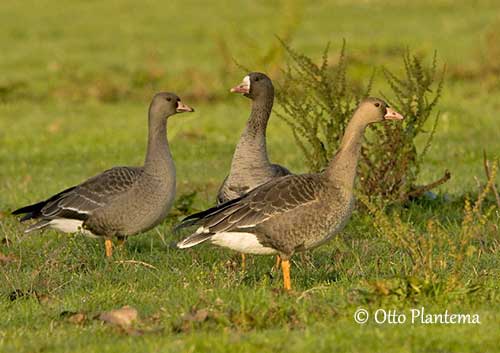
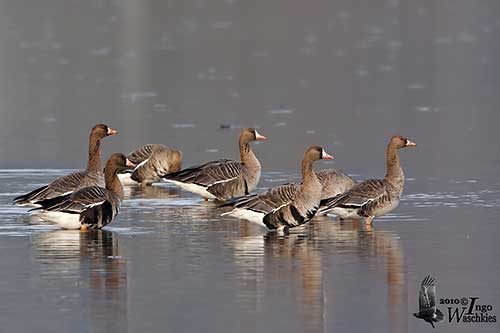
PROTECTION / THREATS / STATUS:
The Greater White-fronted Goose is vulnerable to predators during the nesting season, and the Glaucous Gull often takes the chicks. The species is threatened by hunting pressure, disturbance, poisoning by pesticides on cultivated areas, and diseases.
Climatic changes may involve reduction of the northern range. Oil-pollution, habitat destruction, human disturbances and competition for food are also a problem.
The population trend is uncertain, with some increasing populations in North America and Netherlands, while some others are decreasing.
But in spite of these problems, the Greater White-fronted Goose is currently evaluated as Least Concern.
